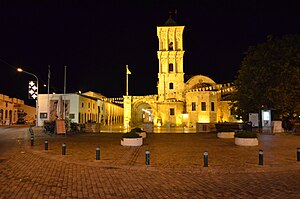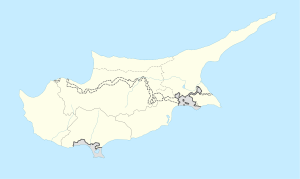Larnaca, Cyprus
| Larnaca | ||||||
|---|---|---|---|---|---|---|
From top left to right: Athinon Avenue, the fort, salt lake and the Hala Sultan Tekke, the Church of Saint Lazarus
|
||||||
|
||||||
| Location in Cyprus | ||||||
| Coordinates: 34°55′N 33°38′E / 34.917°N 33.633°ECoordinates: 34°55′N 33°38′E / 34.917°N 33.633°E | ||||||
| Country |
|
|||||
| District | Larnaca District | |||||
| Government | ||||||
| • Type | Municipal council | |||||
| • Mayor | Andreas Vyras | |||||
| Elevation | 85 ft (26 m) | |||||
| Population (2011) | ||||||
| • City | 51,468 | |||||
| • Urban | 84,591 | |||||
| The urban population is the aggregate of the populations of Larnaca, Aradippou, Livadia, Dromolaxia and Meneou. | ||||||
| Time zone | EET (UTC+2) | |||||
| • Summer (DST) | EEST (UTC+3) | |||||
| Area code(s) | +357 24 | |||||
| Website | www |
|||||
Larnaca (Greek: Λάρνακα [ˈlarnaka]; Turkish: Larnaka or İskele) is a city on the southern coast of Cyprus and the capital of the eponymous district. It is the third-largest city in the country, after Nicosia and Limassol, with an urban population of 84,591 (2011).
Larnaca is known for its palm-tree seafront, the Church of Saint Lazarus, the Hala Sultan Tekke, the Kamares Aqueduct and its medieval fort. It is built on the ruins of ancient Citium, which was the birthplace of Stoic philosopher Zeno.
Larnaca is home to the country's primary airport, Larnaca International Airport. It also has a (both passenger and cargo) seaport and a marina.
Larnaca might have taken its name from the many larnakes (sarcophagi) that are found in the area. Sophocles Hadjisavvas, a state archeologist, states that "[the city's U.S.] consul of the last quarter of the 19th century, claimed to have explored more than 3,000 tombs in the area of Larnaca, so-called after the immense number of sarcophagi found in the modern town".
The former city-kingdom of Kition was originally established in the 13th century BC. New cultural elements appearing between 1200 BC and 1000 BC (personal objects, pottery, new architectural forms and ideas) are interpreted as indications of significant political changes and the arrival of the Achaeans, the first Greek colonists of Kition. Around the same time, Phoenicians settled the area.
...
Wikipedia






